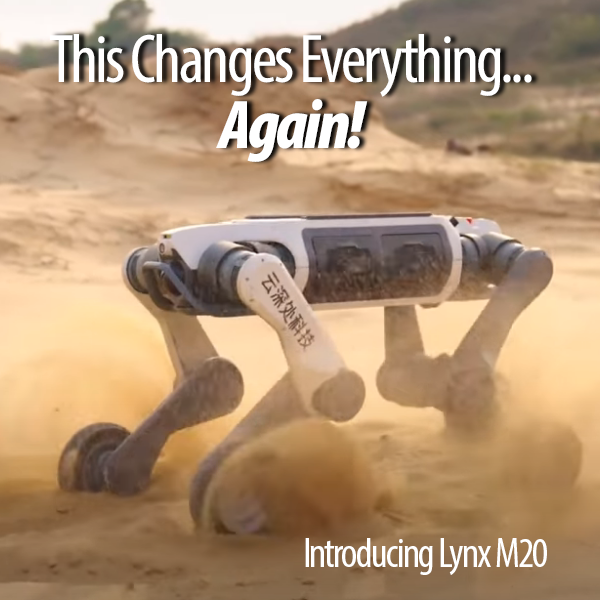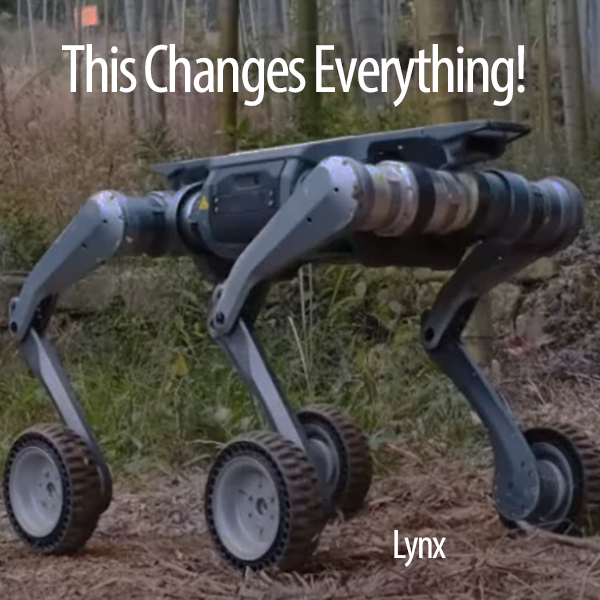This speedy, vaulting, climbing terrain-terror is an amazing breakthrough in the tech-breeding of four-legged robodogs, and now has a big brother. Woof!
A new breed of robodog has arrived
DEEP Robotics certainly didn’t invent the idea of the quadruped robotdog, but it sure as hell has elevated the high-tech canine to an unprecedented level of capabilities with its amazing Lynx. This any-terrain nimble speedster is truly the next evolution in the species that make all other robodogs pale by comparison.
In a world half-agog with off-road vehicles and mountain bikes, it’s a bit surprising that no one had previously thought to add wheels to a robodog’s paws. Actually, it goes to highlight the inventiveness of the DEEP Robotics crew of engineers and physicists. They didn’t overlook simplicity and the commonplace. They blended mechatronics and GenAI with the oldest of humankind’s inventions, the wheel.
And it’s a winner! Check out the M20 UPGRADE video.
Watching the video of Lynx in action is like witnessing first-hand the robodog evolution. Stunningly remarkable is what this motorized canine can do out by itself in most any kind of terrain.
If you’re ever lost in the dark of New Hampshire’s deadly White Mountains, where gale-force winds, rain, sleet, freezing temps. then killer snow can instantly change a delightful walk in the forest into a nightmare, a few of these robodogs hunting for you might be the difference between a warm blanket and tragedy.
The most recent study done by Yosemite National Forest Search and Rescue “showed that 4,661 people per year were lost in the woods and required assistance. That equates to 13 people per day.” The duration of SAR missions averaged 5 hours, used 12 SAR personnel, and cost $4400. Helicopter was the primary mode of transport in 28% of SAR incidents. Nationwide, it’s estimated that 50,000 search and rescue missions are conducted each year.
SAR’s are expensive and dangerous to rescue personnel, and it’s easy to see how a Lynx pack could mitigate much of the expense, danger, and time.
AI and robotics convergences on the rise
DEEP Robotics, a Chinese company based in Hangzhou (founded in 2017), has introduced the Lynx, an advanced wheeled quadruped robot designed for all-terrain use.
DEEP is among a growing cohort of young robot builders in China, like Robot X Lab, and Pudu Robotics, among many others, that are converging AI with robotics to create highly advanced, unique robotics of amazing utility. Even the well-known, like Geek+, are quickly applying AI accelerants to entire product lines.
WHO NEEDS WHEELS WHEN THERE’S PUDU’S D7?
Known for its expertise in developing quadrupedal robots for industrial purposes, (See showcase: 2024 ICRA, Yokohama), DEEP Robotics newest addition to its line of mechanical hounds, Lynx, stands out for its agility and capability to tackle rugged environments. Unlike its predecessors, which featured solid feet, the Lynx moves on four wheels, giving it an appearance reminiscent of quad bikes blended with sophisticated robotic mechanisms.
In addition, they use high-resolution cameras and LiDAR to map environments when locating the lost, or survivors or hazardous materials.
The Lynx is engineered to handle steep slopes, navigate obstacles, and traverse complex terrains with impressive ease. Demonstrations have shown the robot moving swiftly through woodland settings, scaling 50-degree inclines, and overcoming obstacles like rocks and low walls. It can switch seamlessly from standing on four wheels to balancing on two, perform backflips, and execute sharp turns at high speed.
The wheeled Lynx, with its multi-terrain capabilities, has been used in search and rescue, inspection, mapping, and equipment transport. Its high-resolution cameras and LiDAR map environments to locate the lost, or survivors, or hazardous materials.
In the field, the Lynx robot’s battery can last a surprising 4.5 hours in demanding terrain—or up to 9 hours in more favorable terrain. The battery is swappable, and you can purchase an additional spare battery. The battery is made of lithium-ion cells with a 36 V rated voltage and 20 Ah capacity, with fender lights that indicate when the battery is low, using two different animations: Orange stripes: The battery level is below 40% (36 volts); and red stripes: The battery level is below 10% (33 volts).
According to Wei Tang, head of algorithm engineering at DEEP Robotics, “Teams working on emergency searches or for site exploration commonly face challenges such as insufficient site data and risks to their personal safety. That’s where these robots can provide valuable assistance.” Tang emphasized that the use of autonomous robots not only minimizes communication costs but also enhances the efficiency of rescue missions, leading to better outcomes.
Pushing the boundaries of embodied AI
The Lynx’s introduction highlights DEEP Robotics’ commitment to advancing the field of robotics by integrating AI for autonomous adaptability. Under the “DEEP Robotics AI-Plus Plan,” the company seeks to push the boundaries of embodied AI to empower its robots with enhanced capabilities, such as perception, planning, and decision-making.
This strategic initiative aims to integrate reinforcement learning into robot development, allowing for better terrain adaptation and intelligent responses with fewer pre-programmed policies.
Such advancements make robots like the Lynx more robust, adaptable, and able to handle dynamic environments efficiently.
Reinforcement learning and AI integration are crucial to broadening the scope of applications for DEEP Robotics’ products. A senior company official, pointed out that leveraging reinforcement learning helps in creating more intelligent robots capable of adjusting to various terrains and complex tasks autonomously.
This aligns with DEEP Robotics’ vision of enhancing human-machine interaction and bringing practical, AI-powered robotics to a wide range of industries.
Just seven years to Lynx
In a quick seven years, the company has made significant inroads into international markets, with its products being used in more than a dozen countries, including North America, Western Europe, Japan, Korea, and regions in the Middle East.
A unique strength of DEEP Robotics lies in its extensive data collection from real-world use, which facilitates the smooth transfer of simulation-based algorithms to physical prototypes—a significant hurdle for many robotics companies. This approach not only ensures that DEEP Robotics’ robots are ready for real-world deployment but also accelerates development cycles for new models like the Lynx.
Looking ahead, DEEP Robotics plans to deepen its exploration of AI applications in robotics. This includes improvements in human-machine interaction, where robots can better understand and respond to human commands and environments. By integrating advanced perception and decision-making processes, the company aims to refine how its robots function in industrial and possibly domestic settings.
Lynx represents a leap forward for DEEP Robotics, combining rugged, all-terrain functionality with advanced AI capabilities to serve a variety of sectors.
The company mission is to drive continuous innovation and strategic AI integration, and its tech looks amazingly ready to push the boundaries of what autonomous machines can achieve.
If Lynx is any indication of what’s to come, then DEEP has uniquely positioned itself to revolutionize the field.
Well, now we know “what’s to come.”
DEEP Robotics’ Lynx and Lynx M20: The Evolution of All-Terrain Robodogs
The world of quadruped robots has seen rapid advancements, with DEEP Robotics emerging as the key innovator. While the company didn’t pioneer the robodog concept, its Lynx series has redefined what these machines can achieve—blending agility, rugged durability, and AI-driven intelligence.
Lynx: The agile, wheeled pioneer
DEEP Robotics’ original Lynx robodog stands out for its unique wheel-leg hybrid design, a breakthrough in quadruped mobility. Unlike traditional robodogs with static feet, Lynx rolls on four wheels, combining the stability of a quadruped with the speed and fluidity of a wheeled robot. This innovation allows it to traverse rough terrain, climb steep slopes (up to 50 degrees), and even perform dynamic maneuvers like backflips and sharp turns.
Designed for search and rescue (SAR), inspection, and exploration, Lynx is equipped with high-resolution cameras and LiDAR for real-time environmental mapping. Its battery lasts up to 4.5 hours in demanding conditions (or 9 hours in lighter use), with swappable lithium-ion packs ensuring continuous operation.
Wei Tang, head of algorithm engineering at DEEP Robotics, highlights its value in emergency scenarios: “Teams working on emergency searches face challenges like insufficient site data and safety risks. These robots minimize communication costs and improve mission efficiency.”
Under the company’s “AI-Plus Plan,” Lynx leverages reinforcement learning for autonomous decision-making, adapting to terrain without extensive pre-programming. This approach has positioned DEEP Robotics as a leader in embodied AI, with its robots deployed across North America, Europe, and Asia.
Lynx M20: The rugged industrial upgrade
Building on Lynx’s success, DEEP Robotics recently unveiled the Lynx M20, a heavy-duty variant engineered for extreme industrial environments. Marketed as the world’s first wheeled-legged robot for hazardous terrain, the M20 excels in infrastructure inspection, disaster response, and logistics.
Key enhancements:
- All-weather durability: IP66-rated waterproof and dustproof protection, operating in temperatures from -20°C to 55°C (-4°F to 131°F).
- Enhanced mobility: Locks wheels for walking mode, climbs 31.5-inch obstacles, and navigates gaps as narrow as 20 inches.
- Speed & payload: Hits 12 mph max speed (4.5 mph typical), carries 33 lbs, and tackles 45-degree inclines.
- Advanced sensors: Features 96-line LiDAR for 360° awareness and bi-directional lighting for low-visibility operations.
- Extended missions: Hot-swappable batteries support continuous use beyond its 2.5–3-hour runtime.
A “Pro” version adds autonomous charging, SLAM navigation, and Gigabit Ethernet for high-stakes deployments. Pricing remains undisclosed, but given the standard Lynx’s ~$18,000 tag, the M20 is likely a premium investment.
The future of robotic quadrupeds
DEEP Robotics’ rapid evolution—from the agile Lynx to the industrial-grade M20—demonstrates the growing convergence of AI and robotics. With applications spanning SAR, logistics, and hazardous inspections, these robodogs are pushing the boundaries of autonomous machines.
As the company refines human-robot interaction and expands AI integration, the Lynx series might soon become the indispensable, industrial, and emergency go-to, specialist robot. If the M20 is any indication, the next generation of robodogs will be tougher, smarter, and more versatile than ever. For now, let’s just call it the Rolls Royce of robodogs.



